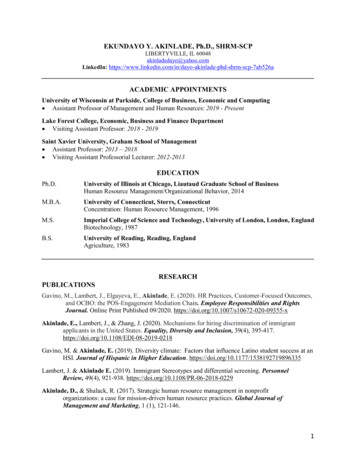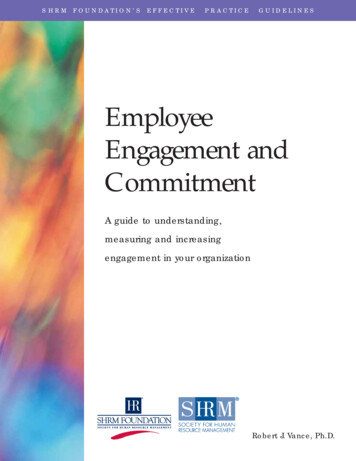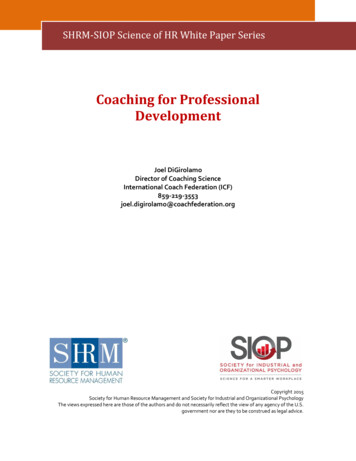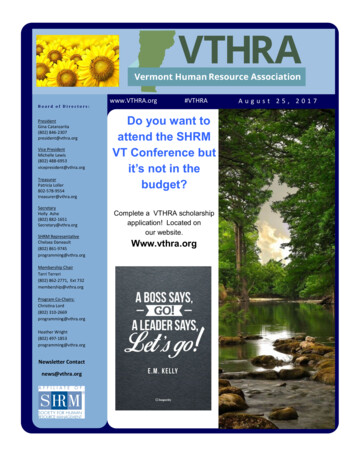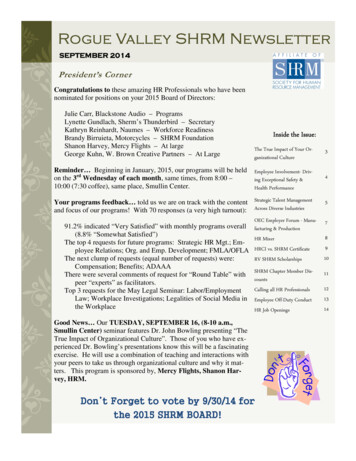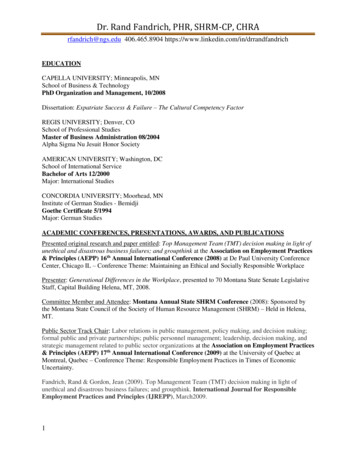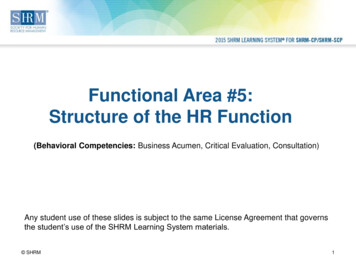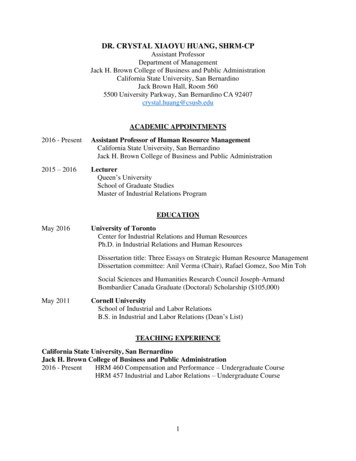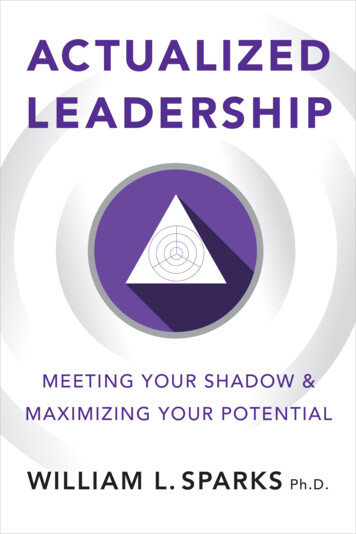
Transcription
What motivates great leaders to achieve their best? The need for self-actualization—the driveto reach one’s highest potential—is the foundation for personal and organizational effectiveness.Based on the seminal works of Carl Jung, Abraham Maslow, David McClelland, and ViktorFrankl, Dr. William Sparks' groundbreaking new book shows how actualized leaders think, feel,and manage differently while providing practical strategies for developing a more actualizedapproach to leadership.The first research-based book to operationalize Abraham Maslow's highly influential theory onhuman motivation for leaders, the book cites nine thinking, feeling, and behavioral traitscommon to self-actualized leaders and gives readers an opportunity to develop these traits inthemselves as they work through a unique and free self-assessment tool called the "actualizedleader profile" (http://www.alpfree.com).The book features interviews with some of today's most respected and successful leadersincluding Cathy Bessant, Chief Operations and Technology Officer at Bank of America; AllyFinancial CEO Jeff Brown; the Presiding Bishop of the Episcopal Church, the Most ReverendMichael Curry; and a foreword by General Motors Chief Technology Officer Dr. MichaelArena.
Actualized LeadershipMeeting Your Shadow & Maximizing Your Potential
ActualizedLeadershipMeeting Your Shadow &Maximizing Your PotentialWilliam L. Sparks, PhDSociety for Human Resource ManagementAlexandria, Virginia shrm.orgSociety for Human Resource Management, India OfficeMumbai, India shrmindia.orgSociety for Human Resource ManagementHaidian District Beijing, China shrm.org/cnSociety for Human Resource Management, Middle East and Africa OfficeDubai, UAE shrm.org/pages/mena.aspx
Copyright 2019 William L. Sparks. All rights reserved.This publication is designed to provide accurate and authoritative informationregarding the subject matter covered. It is sold with the understanding thatneither the publisher nor the author is engaged in rendering legal or otherprofessional service. If legal advice or other expert assistance is required, theservices of a competent, licensed professional should be sought. The federal and state laws discussed in this book are subject to frequent revision andinterpretation by amendments or judicial revisions that may significantly affectemployer or employee rights and obligations. Readers are encouraged to seeklegal counsel regarding specific policies and practices in their organizations.This book is published by the Society for Human Resource Management(SHRM). The interpretations, conclusions, and recommendations in this bookare those of the author and do not necessarily represent those of the publisher.This publication may not be reproduced, stored in a retrieval system, ortransmitted in whole or in part, in any form or by any means, electronic,mechanical, photocopying, recording, or otherwise, without the prior writtenpermission of the publisher, or authorization through payment of the appropriate per-copy fee to the Copyright Clearance Center Inc., 222 RosewoodDrive, Danvers, MA 01923, 978-750-8600, fax 978-646-8600, or on theweb at www.copyright.com. Requests to the publisher for permission shouldbe addressed to SHRM Book Permissions, 1800 Duke Street, Alexandria,VA 22314, or online at rmissions.aspx. SHRM books and products are available onmost online bookstores and through the SHRMStore at www.shrmstore.org.SHRM, the Society for Human Resource Management, creates betterworkplaces where employers and employees thrive together. As the voiceof all things work, workers and the workplace, SHRM is the foremostexpert, convener and thought leader on issues impacting today’s evolving workplaces. With 300,000 HR and business executive members in165 countries, SHRM impacts the lives of more than 115 million workersand families globally. Learn more at SHRM.org and on Twitter @SHRM.Library of Congress Cataloging-in-Publication DataNames: Sparks, William L., author.Title: Actualized leadership : meeting your shadow and maximizing yourpotential / William L. Sparks, PhD.Description: First edition. Alexandria, VA : Human Resource Management,[2019] Includes bibliographical references and index.Identifiers: LCCN 2019012959 ISBN 9781586445683 (pbk. : alk. paper) ISBN 9781586445706 (epub) ISBN 9781586445713 (mobi)Subjects: LCSH: Leadership.Classification: LCC HD57.7 .S69425 2019 DDC 658.4/092--dc23 LCrecord available at https://catalog.loc.gov/vwebv/search?searchCode LCCN&searchArg 2019012959&searchType 1&permalink yPrinted in the United States of AmericaFIRST EDITIONPB Printing 10 9 8 7 6 5 4 3 2 161.19302
Table of ContentsList of Tables and FiguresForeword ixPreface xiiiAcknowledgments xviiSpecial Introduction xixviiPart IMeeting Your ShadowChapter 1Chapter 2My F in Life. . . . . . . . . . . . . . . . . . . . . . . . . . . . . . . . . . . . . . . 3The Myth of Self-Awareness. . . . . . . . . . . . . . . . . . . . . . . . . . 15Part IILeadership and Organizational DynamicsChapter 3Chapter 4Actualized Leadership: A Framework. . . . . . . . . . . . . . . . . . . . 27Leader and Team Dynamics . . . . . . . . . . . . . . . . . . . . . . . . . . 37Part IIIActualized LeadershipChapter 5Chapter 6Chapter 7Chapter 8Cognition: How Actualized Leaders Think. . . . . . . . . . . . . . . 59Emotion: How Actualized Leaders Feel. . . . . . . . . . . . . . . . . . 73Behavior: What Actualized Leaders Do. . . . . . . . . . . . . . . . . . 87The 3 Sequences of Self-Actualization. . . . . . . . . . . . . . . . . . 101Part IVThe Transformational JourneyChapter 9Chapter 10Appendix AAppendix BAppendix CIntegrating Your Leadership Shadowand the Transformational Change Cycle. . . . . . . . . . . . . . . . . . 115Beyond Leadership: Humility, Happiness, Passion, and Purpose . . 139The ALP Styles at a Glance. . . . . . . . . . . . . . . . . . . . . . . . . . 151Developmental Resources. . . . . . . . . . . . . . . . . . . . . . . . . . . 153Technical Statement: Reliability and Validity for the ALP. . . . 155References 185Index 193About the Author 199v
List of Tables and FiguresTablesTable 1.1.Summary of the Actualized Performance Framework. . . . . . . . . 12Table 1.2.Nine Attributes of Actualized Leaders . . . . . . . . . . . . . . . . . . . . 14Table 3.1.McClelland’s Three Drivers and Corresponding ActualizedLeadership Styles . . . . . . . . . . . . . . . . . . . . . . . . . . . . . . . . . . . . 30Table 4.1.The Fear of Failure Leadership Cycle. . . . . . . . . . . . . . . . . . . . . 44Table 4.2.The Fear of Rejection Leadership Shadow Cycle. . . . . . . . . . . . . 45Table 4.3.The Fear of Betrayal Leadership Shadow Cycle. . . . . . . . . . . . . . 45Table C.1.Motive Needs and Their Relationship to Leader Behaviors. . . . 157Table C.2.Leadership Shadows in the Context of the ALP Framework. . . 163Table C.3.Six Steps in the Scale Development Process . . . . . . . . . . . . . . . 166Table C.4.Demographic Characteristics of Study Sample . . . . . . . . . . . . . 170Table C.5.PCFA Factors. . . . . . . . . . . . . . . . . . . . . . . . . . . . . . . . . . . . . . 173Table C.6.Total Variance Explained . . . . . . . . . . . . . . . . . . . . . . . . . . . . . 173Table C.7.Scale Component Ranges. . . . . . . . . . . . . . . . . . . . . . . . . . . . . 173Table C.8.ALP Factor Loadings. . . . . . . . . . . . . . . . . . . . . . . . . . . . . . . . 174Table C.9.Reliability Assessment: Cronbach’s Alpha. . . . . . . . . . . . . . . . . 175Table C.10.Achievement Scale: Inter-Item Correlation Matrix. . . . . . . . . . 177Table C.11.Achievement Scale: Item-Total Statistics. . . . . . . . . . . . . . . . . . 177Table C.12.Affiliation Scale: Inter-Item Correlation Matrix . . . . . . . . . . . . 177Table C.13.Affiliation Scale: Inter-Total Statistics. . . . . . . . . . . . . . . . . . . . 177Table C.14.Power Scale: Inter-Item Correlation Matrix. . . . . . . . . . . . . . . 178Table C.15.Power Scale: Item-Total Statistics. . . . . . . . . . . . . . . . . . . . . . . 178Table C.16.Self-Actualization Scale: Inter-Item Correlation Matrix. . . . . . . 179Table C.17.Self-Actualization Scale: Item-Total Statistics. . . . . . . . . . . . . . 179Table C.18.Word Pairs: Cronbach’s Alpha . . . . . . . . . . . . . . . . . . . . . . . . . 179Table C.19.Word-Pair Achievement Scale: Inter-Item Correlation Matrix. . 180Table C.20.Word-Pair Achievement Scale: Item-Total Statistics . . . . . . . . . 180Table C.21.Word-Pair Affiliation Scale: Inter-Item Correlation Matrix. . . . 181Table C.22.Word-Pair Affiliation Scale: Item-Total Statistics. . . . . . . . . . . . 181vii
viii List of Tables and FiguresTable C.23.Word-Pair Power Scale: Inter-Item Correlation Matrix. . . . . . . 181Table C.24.Word-Pair Power Scale: Item-Total Statistics . . . . . . . . . . . . . . 181Table C.25.Word-Pair Self-Actualization Scale: Inter-Item Correlation Matrix. . . 182Table C.26.Word-Pair Self-Actualization Scale: Item-Total Statistics. . . . . . 182FiguresFigure 3.1.Maslow’s Hierarchy of Needs. . . . . . . . . . . . . . . . . . . . . . . . . . . 33Figure 4.1.The Achiever Style. . . . . . . . . . . . . . . . . . . . . . . . . . . . . . . . . . . 40Figure 4.2.The Affirmer Style. . . . . . . . . . . . . . . . . . . . . . . . . . . . . . . . . . . 40Figure 4.3.The Asserter Style. . . . . . . . . . . . . . . . . . . . . . . . . . . . . . . . . . . . 41Figure 4.4.The Actualized Performance Cycle. . . . . . . . . . . . . . . . . . . . . . . 55Figure 8.1.The Confidence Sequence . . . . . . . . . . . . . . . . . . . . . . . . . . . . 104Figure 8.2.The Performance Sequence . . . . . . . . . . . . . . . . . . . . . . . . . . . 107Figure 8.3.The Renewal Sequence. . . . . . . . . . . . . . . . . . . . . . . . . . . . . . . 109Figure C.1Maslow’s Hierarchy of Needs. . . . . . . . . . . . . . . . . . . . . . . . . . 165
ForewordOne of my all-time favorite movies is The Legend of Bagger Vance.The film’s main character is a supremely gifted professionalgolfer named Rannulph Junuh, who is consumed by the shadowsof a tragic life experience. As a result, he has been knocked off life’scourse; he has lost his game. His caddy, Bagger Vance, has decidedto journey through the torturous dark valley with him. Unbeknownto Junuh, Bagger is committed to helping him reach his full potential, acting as a personal sage. During a poignant moment in themovie, Junuh finds himself alone in the dark shadowy woods aftershanking his ball off course. In this moment, he is consumed by theflooding memories of the tragic past that has haunted him for years.Trembling in terror, he leans over to pick up his ball, preparing togive up, to quit once and for all. Then, seemingly out of nowhere,Bagger emerges and asks the question, “You going to be wantinga different club there, Junuh?” Stunned by his caddy’s presence,Junuh responds, “I can’t do this,” and he goes on to say, “You don’tunderstand.” Bagger responds, “I don’t need to understand. Thereain’t a soul on this entire earth that ain’t got a burden to carrythat he don’t understand. You ain’t alone with that, but you havebeen carrying this one long enough. Time to go on, lay it down . . .time for you to come on out of the shadows, Junuh. Time for youto choose.”In Actualized Leadership, Will Sparks is also asking you to choose,to come out of your own darkness and choose to reach your optimalpotential. To do so, Sparks argues that we must confront our ownshadow. We must move past our own tragic past and get back onthe course of our life’s purpose in pursuit of our own personal why.Heavily influenced by Swiss psychologist Carl Jung’s concepts ofindividuation (the process of actualizing our ultimate potential) andix
x Forewordthe shadow (the unconscious and often irrational aspect of our ownpersonality that is triggered under stress), Sparks challenges us tolook at the dark side of how we show up as leaders. He will encourage you to step out of what Jung referred to as your “fog of illusion”and to stop blaming your troubles on others, to come out of theshadows and realize your highest potential. Actualized Leadershipacts as a personal sage, much like Bagger Vance, but through thewords of a book.Grounded in the seminal theoretical foundations of such authorities as Jung, Abraham Maslow, Mihaly Csikszentmihalyi, DavidMcClelland, and Viktor Frankl, Actualized Leadership provides asynthesized framework grounded in twenty years of research andinquiry. The book argues that individuals are represented by one ofthree positive motivation needs and their resulting styles: Achiever,Affirmer, or Asserter. Each leadership style has a unique corresponding leadership shadow—Fear of Failure (Achiever), Fear of Rejection(Affirmer), or Fear of Betrayal (Asserter)—which often produces less-than-optimal results, if not outright dysfunction, under stress.Sparks reminds us that we have a choice: we can choose to meet andprocess our shadow, or we can ignore or deny it, and it will processand manage us. Drawing on the wisdom of Viktor Frankl’s notion ofparadoxical intent, he argues that the more we let the fear underlying our leadership shadow drive our behavior, the more likely we areto experience the very thing we are trying to avoid: failure, rejection,or betrayal.Much has been written on leadership and positive psychologyover the past decade, with many organizations strongly embracingthe notion that we must focus on people’s strengths rather thantheir weaknesses. These organizations believe that the creation ofa positive working environment encourages everybody to be theirbetter selves. In Actualized Leadership, Sparks takes us a step beyondthis notion. He argues that focusing only on our strengths whileexcluding, denying, or projecting our shadow is only one-halfof the self-awareness equation. He challenges us to spend time
Foreword xidiscovering our deep, personal reason for what we do. He thenmoves beyond the accentuation of positive motivations and encourages us to charge into our own internal disturbances as a basis toovercome the influence of our unconscious leadership shadow. Indoing so we are able to unshackle ourselves from the dark side ofour own egos to ascend toward the pinnacle of our higher selves,our actualized potential.Years ago, my mentor taught me that my primary responsibility as a catalyst for human development is to hold up mirrors toothers so they can see themselves more vividly. In some cases, thisreflects the sheer hidden brilliance deep inside of an individual. Inother cases, it magnifies the brutal truth of how an individual’s shadows show up for others. As a chief talent officer, I have found thatboth of these practices are essential for leadership growth. We mustuncover the hidden potential in others, and we must also challengeothers to deal with their repressive egos. In Actualized Leadership,Sparks goes even further. He does the unthinkable. He turns themirror around and openly shares the brutal realities of his own leadership journey as a testimony to others so that they can choose.This choice has perhaps never been more important. In today’sworld, more than ever, leaders need to enable resilience in theirorganizations. This journey begins by looking in the mirror. We livein the era of disruption, where the lack of agility is the kiss of death.John Chambers, chairman emeritus of Cisco, said that “if you don’ttransform . . . if you don’t reinvent yourself, change your organization structure; if you don’t talk about speed of innovation—you’regoing to get disrupted. And it’ll be a brutal disruption, where themajority of companies will not exist in a meaningful way 10 to15 years from now.” A study from Washington University predictsthat an estimated 40 percent of today’s S&P 500 companies will nolonger exist a decade from now (Ioannou, 2014). This reality leavesorganizations with a critical choice: adapt or die. To do so, organizations truly need actualized leaders, leaders who can see beyondtheir own egos and help the organization face the tough realities
xii Forewordof a changing world. This means that leaders must first face theirown demons and charge into their leadership shadow. Tragically,my personal experience is that leaders want all the glory of leadingwithout the cost. Few leaders are willing to pay the price necessaryto charge into their shadow and do the deep work required for leading resilient, adaptive organizations. For those of you who chooseto do so, those of you who are willing to plunge into this journeyfor the sake of your institutions, Actualized Leadership can serve asyour sage in your own personal moments of doubt and frustrationin the darkness.—Michael J. Arena, PhDChief Talent Officer of General MotorsAuthor of Adaptive Spacewww.adaptivespace.net
PrefaceActualized Leadership is about you and your development.Although this book is written primarily for a business audience—specifically, leaders in organizational settings—its centralmessage of how to unleash, or actualize, your potential is a messagethat any reader seeking personal transformation will find relevantand life changing.Actualizing your potential requires balancing two seeminglycontradictory states: honesty and objectivity about your currentstate, as well as imagination and passion for a desired future state.You must be willing to make a strong commitment to seriouslypursue your own unique development and growth pathways. TheActualized Leader Profile I’ve developed is the culmination of morethan twenty years of research. It provides a scientifically valid andreliable method to accurately assess both your strengths and limitations. This book will support your effort to develop an even deeper,more encompassing degree of self-awareness.At some point, assuming I do my job effectively, you may feeldiscomfort or even irritation with this process. If that happens,we’ve both done our jobs. True self-awareness is not always comforting or validating; it sometimes disturbs and disrupts. However,this disturbance pushes us to find reservoirs of strength that help usreach our highest potential, leading us to transform ourselves andour relationships with others. This ultimately awakens us to newways of leading and living.Actualized Leadership is the first published research-based bookto put into practice Abraham Maslow’s highly influential theory ofhuman motivation—specifically his concept of self-actualization—within the context of an organizational leadership setting. Throughscientific analysis, I’ve identified nine specific traits that characxiii
xiv Prefaceterize the unique way self-actualized leaders think, feel, and act.Years of personal research in the field of organizational and leadership development have revealed a compelling business case forwhy self-actualization is so essential to your success as a leader. Asyou develop and enhance your self-actualization, you’ll feel moresatisfied and inspired as a leader. You’ll also achieve better results andcreate a more engaged and effective company culture.This book gives you the opportunity to directly apply the modelsand concepts of self-actualized leadership to yourself. As you workyour way through the pages you will build your unique ActualizedLeader Profile (ALP) report that you can use to guide your transformational journey. As with any roadmap, you’ll be able to choosewhere to begin and end your journey. This flexibility allows you todive into the sections that are most applicable to your specific needsfor leadership development.Many of my participants have told me that going through thedevelopment program benefited their personal lives as much as, ifnot more than, their professional lives. The fact is that you simplycannot separate leadership development from personal growth.Human growth, which is foundational for individual development,occurs when someone changes his or her internal belief structure.This type of growth takes place when, for example, as the resultof a 360-degree assessment a person gains a new, profound insightthat then leads to a significant shift in the way she sees herself, andothers, which leads to personal transformation.While leader styles, shadows, and the 9 Attributes of ActualizedLeaders discussed in this book are based on years of quantitativeresearch and scientific validation, many of the insights and suggestions come from qualitative interviews with some of today’smost respected and successful leaders. They include former Bankof America Chairman and CEO Hugh McColl and EpiscopalPresiding Bishop of the United States the Most Reverend MichaelCurry, among others. These leaders eagerly shared their knowledgeand straightforward, no-nonsense wisdom based on years of diverse
Preface xvexperience in a wide variety of industries. The leaders who have sograciously given of their time, energy, and expertise for this bookare, in alphabetical order:»»»»»»»»»»»»»»»»»»John Allison, retired Chairman and Chief Executive Officer,BB&TCarl Armato, Chief Executive Officer, Novant HealthcareCathy Bessant, Chief Operations and Technology Officer, Bankof AmericaJeff Brown, Chief Executive Officer, Ally FinancialThe Most Reverend Michael Curry, Presiding Bishop,The Episcopal ChurchPamela Davies, PhD, President, Queens University of CharlotteHugh McColl, retired Chairman and Chief Executive Officer,Bank of AmericaMike McGuire, Chief Executive Officer, Grant ThorntonFred Whitfield, President and Vice Chairman, the CharlotteHornetsMy personal view is that anything you haven’t accomplished inyour professional life up to now is due in large part to what I callyour leadership shadow. Famed Swiss psychologist Carl Jung coinedthe term “the shadow” to describe the dark, negative qualities ofan individual that are activated under stress. These qualities areoften the counterpart to the many positive attributes we possessand embody. Through this book you will have the opportunity tomeet and process your leadership shadow so that it does not process and manage you, releasing you to achieve your highest senseof calling and purpose. The ALP is a tool that helps you accurately identify and own your leadership shadow. The ActualizedLeader Profile, to be completed online, is your essential resourceand companion throughout the book. The most challenging partof the journey will be to stay out of your own way. As you read,consider the cost of not managing your shadow and then assess
xvi Prefacethe price you will continue to pay until you finally decide to meet,and integrate, it.In the end, this book is about helping you find affirmingand self-actualizing experiences more often and about showingyou how to feel them more intensely. I can assure you that if youfully engage in this process, complete the ALP assessment honestlyand accurately, read and consider the suggestions in this book, andcommit to following through with your development, you will bea more effective, happy, and satisfied leader. Consequently, you’llcreate a more engaged culture for your colleagues and associates.And you’ll create a more satisfying life at home.
AcknowledgmentsThere are a number of people I would like to thank for theirinsight, creativity, and support over the years in general, and inwriting this book in particular. First, my business partner John Repedehas been a tremendous colleague over the years, and his combinedgrasp of statistics and creativity with technology is without equal.I want to thank my colleagues at Queens University of Charlotte,especially Pamela Davies and John Bennett, for their ongoing support. I owe a debt of gratitude to my friends at EnPro Industries fortheir interest and support over the years, especially Steve Macadam,Robert McLean, Susan Sweeney, Gilles Hudon, Bill Favensi, MarvinRiley, and Jon Rickers.I want to recognize and thank my business partners Erika Weedand Jane Williams for their commitment to our work, and to thisproject. Thanks to Erin Stump and Stump Design for their creativeinput and design excellence. Mark Morrow and Linda Vespa providedtremendous editorial support. I appreciate Mark reminding me thatI did not need to use twelve words when four would suffice. Linda,thank you for your careful attention to detail, and for your patiencewith my consistent mistakes!A number of folks have provided support and input over the years,including Bob Freese, Kayshia Kruger, Michelle Shail, Maura McGrath,Yeshua Perez, Craig Hopkins, Anderlei Cortez, Peter Macon, and AnnaEsther Mason. Many mentors and business colleagues have helpedshape my thinking, and my writing, and they include Jim Long, JerryHarvey, John Lobuts, Peter Browning, and Ken Walker.I especially want to thank Matt Davis and Montrese Hamiltonwith SHRM’s book-publishing program for their tremendous support and encouragement.Finally, I want to thank my family and my fiancée Erin for theirongoing love and support.xvii
DedicationThis book is dedicated to Dr. Dominic J. Monetta,my mentor, colleague, and dear friend. You taught memore about actualizing potential than anyone else.xviii
Special IntroductionIam pleased that Will asked me to offer my own personal perspective on human development as an introduction to ActualizedLeadership: Meeting Your Shadow & Maximizing Your Potential.Please allow me to start by disclosing that I am by no means anexpert on human development. I have never been formally trainedin this extensive field, nor do I have any credentials to put forward.I only know and believe it to my core—that every human beingis equally worthy, full of perfect goodness and good intention attheir most innate and basic level. This was either taught to me bymy father or was inborn, because it has been part of me since I canremember.This foundational belief shapes my perspective of the worldso much that I have been coached over the years that I am “toonaïve,” “too trusting of others,” “not discerning enough of others’motives,” and the like. I fully accept that feedback; however, Ibelieve as one grows up in our imperfect world, their inborn goodness gets corrupted, twisted, or distorted by the ego-driven aspectsof our society and those of other people. Unfortunately, peopledon’t actually behave perfectly. All of us are left to wrestle with ourown imperfectness as a lifelong struggle of growth and developmentin an attempt to more closely align our internal self with the externalself we desperately want others to see.My second foundational belief is that all human beings are builtfor learning. (I tend to use the terms “learning,” “growth,” and“development” interchangeably.) It’s easy to recognize in youngchildren, harder to recognize in adults, and particularly hard to recognize in adults who appear to have given up on their own growth.But I believe that everyone still has the internal flame of motivationto grow, no matter how dim the light has become.xix
xx Special IntroductionTherefore, my two foundational beliefs about you (and everyone) are that you are inherently good and that you have an innatedesire for learning and growth.If these characteristics are true of everyone, why then do somepeople seem to grow and develop on an accelerated track whileothers stagnate? I have observed in myself and others that muchof the reason has to do with the mechanics or process that wefollow. Let me offer a simple conceptual model to illustrate the twocommon approaches to development that I have experienced andalso observed in others. Frankly, one works and the other doesn’t.The conceptual model is a simple why what how framework. Every person has their own why, which can be thought of astheir purpose for living. It’s the answer to the question “Why areyou here on this earth?” Some of you will know the answer. Othershave yet to discover it, or it is still emerging, and some have a generalsense of the answer but it is not fully clear. I believe that discovering one’s true why at the fundamental level, and living into it, is alifelong pursuit. At EnPro, we spend a significant amount of timeworking on each of our whys.A person’s why leads to a what, either explicitly or subconsciously. This what can be thought of as what one chooses to do with theirtime, both in the present and in the future. This can be applied toone’s profession or education as well as choices in their personal life;it is how one chooses to allocate time in all the various aspects oftheir life.One’s what then finally leads to the how. This is how one actsin the world and toward others. For example, it’s the differencebetween listening and talking, telling and coaching; being patientand impatient, compassionate and cold-hearted, trusting and suspicious; and the like. This why what how model serves as theguiding framework for the two very different developmental pathsthat I have observed.Let me start with the one that has not worked for me and, I daresay, I have not seen work for others. It is the direct shift from one’s
Special Introduction xxicurrent how to a new and better how, without the connection topurpose. “I want to shift from being a poor listener to being a goodlistener,” “from cold-heartedness to compassion,” “from uninspiring to inspirational as a leader.” In my history, I have wanted tochange many undesirable behaviors (hows) to better behaviors, onlyto see my well-intended and earnest efforts fail as I fell back into old,familiar patterns. It’s easy for me to describe better behaviors, but ithas proven very difficult to consistently achieve and sustain them. Ibelieve the answer lies in the process. The mechanics actually matter!I believe they make all the difference.The process that I have found to work much more effectivelytakes a di
approach to leadership. The first research-based book to operationalize Abraham Maslow's highly influential theory on human motivation for leaders, the book cites nine thinking, feeling, and behavioral traits . the notion that we must focus on people’s strengths rather than their wea
